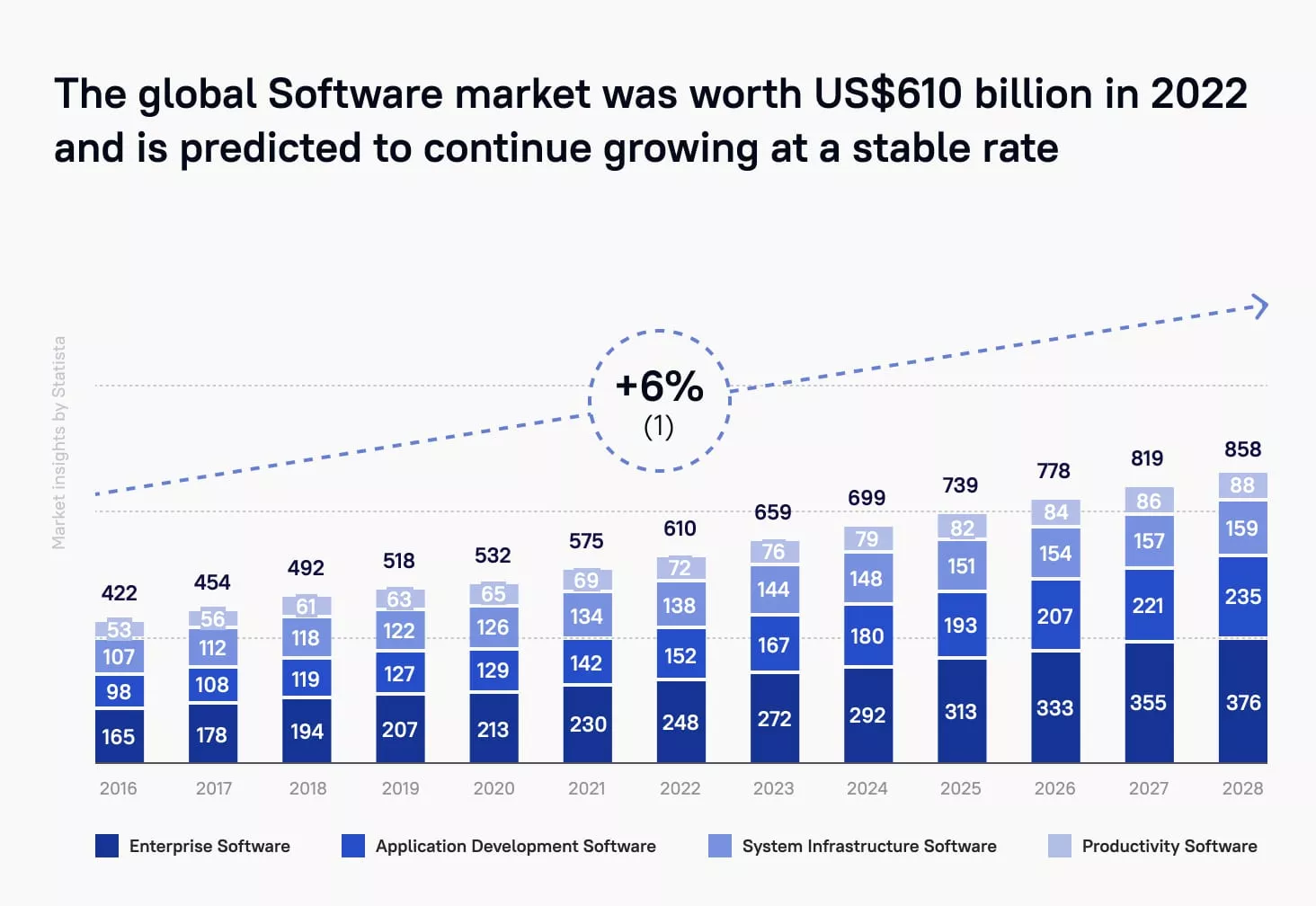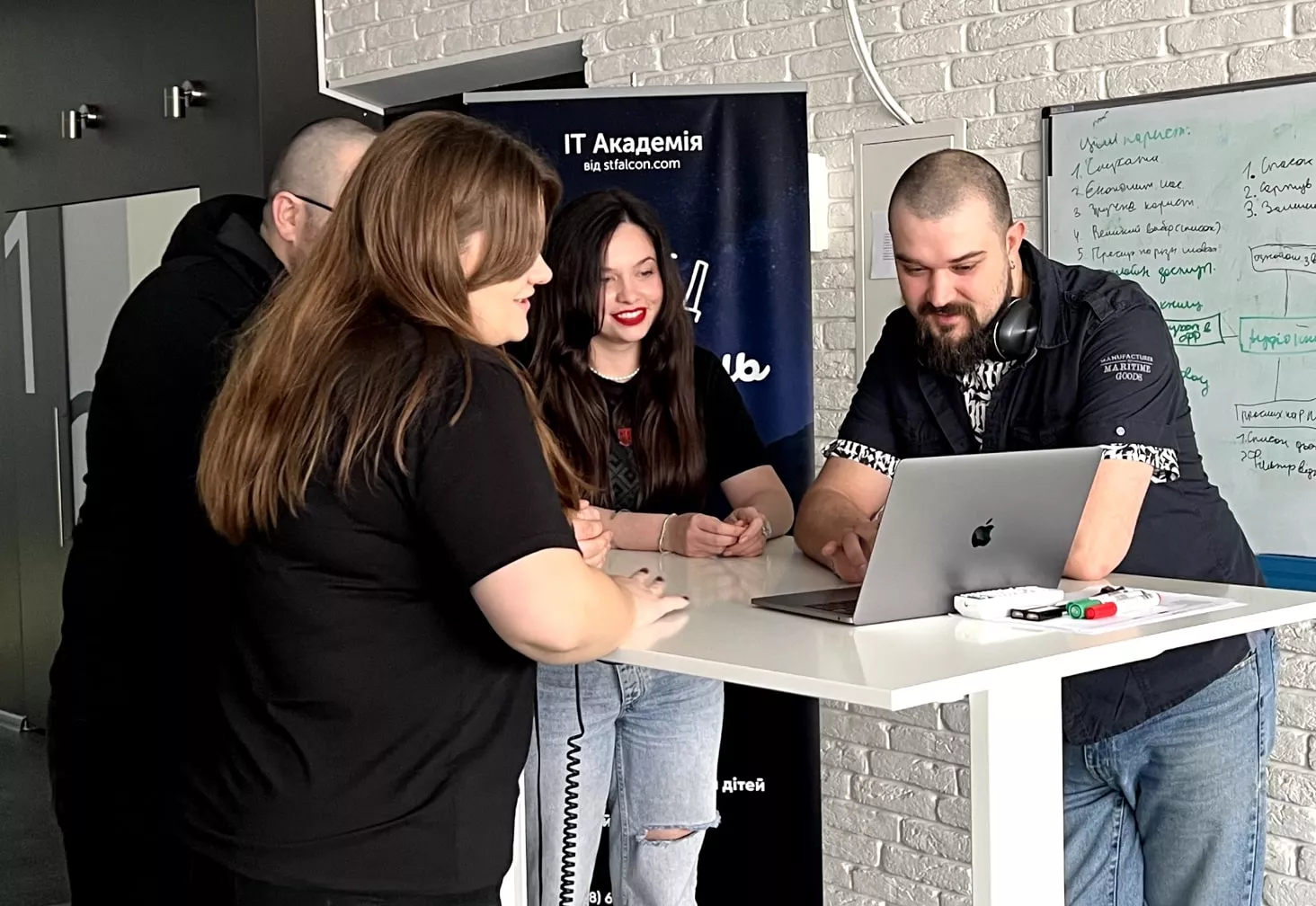
Did you know that the global software development market is projected to reach $858 billion by the end of 2028? Now, take a pause and reflect on your current cost estimation strategies. Are they equipped to keep pace with the rapid evolution of technologies like AI, blockchain, and cloud computing?

Join us on our insightful journey into the realm of software development costs. We will explore the challenges and methodologies to use for the average estimation. Let’s unravel the mystery behind the numbers.
Average Cost of Software Development in 2024
Let’s move on to software development cost estimation. We will consider typical features and the complexity of the project.
Costing the essentials
Here's a breakdown of the typical steps features and their associated costs.
- Front-end development. User interface and smooth user experience are key components of front-end development. The cost of UI/UX design ranges from 15% to 20% of the development budget. This includes wireframing, prototyping, and ensuring an intuitive user journey. While estimating software development costs expect to invest around $35,000 to $40,000 for the front-end.
- Back-end development. The backend developer manages data and logic on the server side. The process involves server configuration, database management, API integration, and security implementation. The cost falls between $40,000 and $100,000. This estimate can vary based on specific project requirements and additional customizations.
- User authentication. A secure login system is the gatekeeper of your digital kingdom. Implementing basic user authentication can cost anywhere from $1,700 to $2,600. It depends on the desired level of encryption and security protocols.
- Payment integration. For e-commerce and financial apps, integrating a payment gateway is a must. This feature can range from $1,500 to $1,900. It depends on the complexity of the transactions and security measures.
- Customization. As no two fingerprints are alike, no two software projects are identical. Customization is the key to ensuring your software aligns with your business requirements. You can build an e-commerce platform or a cutting-edge data analytics tool. The cost of customization is usually around $2,000. Mind the complexity of your project and the specific technologies involved. The degree of personalization required is also important.
- Push notifications. Keeping your audience informed and engaged comes at a price. The implementation of push notifications averages between $650 and $900. The platforms targeted (iOS, Android, or both) influence the cost. The integration with external systems also adds up to this.
- Chat messaging. The average cost of adding messaging functionality hovers between $1,800 and $4,000. The complexity of the chat system influences the price tag. Think of one-to-one, group chats, and multimedia support. The need for end-to-end encryption and seamless integration with third-party APIs also matters.
Testing and quality assurance. A strict testing and quality assurance procedure guarantees the software's functionality, performance, and security. Allocate around 20% of your total budget for a comprehensive testing strategy.
Breaking down costs based on complexity
Now, let's break down the software development costs based on project complexity.
Minimum Viable Product (MVP)
The MVP is the stripped-down version of your software that includes only the essential features for launch. For a simple MVP, you're looking at a cost range of $5,000 to $30,000. This includes user authentication, basic database management, and a simple notification system.Simple software solutions
These are typically single-page applications or small-scale systems. The development cost for such projects ranges from $30,000 to $60,000. Examples include landing pages, basic mobile apps, or straightforward web applications.Moderate software solutions
Moderate complexity involves projects with multiple features, integrations, and user roles. This includes e-commerce platforms, enterprise resource planning (ERP) systems, and comprehensive mobile apps. The cost of developing moderate complexity software is estimated between $60,000 and $150,000.Complex software solutions
Complex projects encompass large-scale systems with intricate functionalities, AI integrations, and extensive databases. Examples include enterprise solutions, advanced e-learning platforms, and sophisticated data analytics tools. The development cost for such projects can surpass $500,000, depending on the project's scope and requirements.
Want a web app that does more?
Let's build a solution that's smart, sleek, and powerful.
Alina
Client Manager

Factors of Software Development Cost Formation
In this section, we will dissect the DNA of custom software development costs. We will explore all the intricacies that define this financial landscape.
Size of the project
The size and complexity of the project are fundamental determinants of its cost. A larger project with more intricate features will demand a greater financial investment. This is because more complex projects need more development time and specialized expertise. They also require a broader range of functionalities.
Timeframe
Time is money, especially in the world of software development. Project timelines directly correlate with costs. Thus, delays can have a cascading effect on both development and next phases.
Tight deadlines may cause overtime, potentially elevating expenses. Balancing efficiency and speed is a delicate dance. Rushing through development may lead to technical debt, resulting in higher long-term costs.
Team
The foundation of any software project lies in its development team. Costs associated with skilled professionals, such as software engineers, UI/UX designers, and project managers, contribute significantly to the budget. With the continued rise of specialized roles like DevOps engineers and AI specialists, understanding the composition of your development team is more intricate than ever.
The skills of developers, PMs, and other members influence development speed and quality. Moreover, the location of the development team can be a major cost factor. Offshore teams may offer cost savings, but effective communication and collaboration become paramount.
Tech stack
The choice of technology stack is akin to selecting the right set of tools for a craftsman. The choices made here impact development speed, scalability, and maintenance costs. From programming languages like Python, Java, and JavaScript to frameworks like React, Angular, or Django, each component plays a role in shaping the overall cost structure.
Opting for the latest and most sophisticated technologies might enhance the project's capabilities. Yet, it often comes at a premium. On the other hand, using outdated technologies can result in higher maintenance costs in the long run. The key is balancing innovation and pragmatism.
Software type
The type of software plays a pivotal role in estimating costs for new software product development. Web applications, for instance, may need extensive front-end and back-end development. Mobile apps demand compatibility across different platforms. Enterprise software often involves complex integrations with existing systems. Compliance with industry standards is also a must in this case. This all contributes to elevated development costs.
Understanding the nuances of the software type is essential for accurate cost estimation. It enables developers and stakeholders to allocate resources effectively. They can also expect potential challenges associated with the specific software category.
Integrations
Integrations allow your software to communicate with external apps, databases, and services. They enhance overall performance and the user experience. Yet, the convenience of integrations comes at a cost. Each integration requires time and effort to implement, test, and maintain.
Syncing data, compatibility issues, and security considerations further complicate integration. The number of systems involved and the need for custom integrations can increase the development time and expenses.
The methodology used
The choice of development methodology significantly impacts costs. Traditional Waterfall methodologies provide a structured approach. However, they might be less adaptive to changing requirements. As a result, this leads to higher expenses in the long run.
Agile methodologies offer flexibility but demand a skilled team capable of rapid iteration. They offer more flexibility, but they can also lead to increased development time and costs.
Infrastructure and hosting costs
Hosting costs are often underestimated, but they can make or break a software project. Cloud services offer scalability and flexibility but come with associated costs. On-premise solutions may provide more control but often require large initial investments.
FAQ
Unlock the answers to the most pressing questions with our FAQ section.
What are the hourly software development rates?
Hourly rates vary depending on the experience level of the developer, their location, and the complexity of the project. You can expect to pay anywhere from $30 to $90 per hour for a software developer.
Here is a breakdown of hourly software development rates by experience level:
- Junior developer: $20-$30 per hour
- Mid-level developer: $30-$50 per hour
- Senior developer: $50-$70 per hour
How do you calculate software development budget?
First, you need to define the scope of the project. Outline the features and functionalities required. Next, estimate the number of hours each task will take. Then, multiply it by the hourly rate of the development team. Add in other costs, such as project management, testing, and deployment. Additionally, factor in any potential unforeseen costs or changes in scope.
Revisiting and adjusting the budget as the project progresses is essential. It helps you ensure accuracy and avoid surprises.
How much does it cost to develop a software application?
Small projects with basic functionalities may cost tens of thousands of dollars. Large, complex apps with more than 50 screens can require budgets of $250,000 or more.
To get a more accurate estimate, consult with experienced software development professionals. They can assess your specific requirements and provide a detailed quote based on the project's scope and objectives. Keep in mind, that investing in a skilled and experienced development team often pays off. It ensures efficiency, quality, and long-term success.
Conclusion
Working with a team that combines expertise, innovation, and a client-centric approach is paramount. Stfalcon emerges as a leader in this space.

A testament to Stfalcon's prowess in the software development realm is its portfolio. Let's explore a few standout cases that showcase our commitment to excellence.
TaskRunner posed a unique challenge - revamping a platform with constant user complaints. Stfalcon conducted a detailed project audit. We estimated costs and risks before opting to recreate the project from scratch. Stfalcon implemented native iOS and Android apps, a web-based admin panel, and a robust backend with REST API.
Clean architecture principles, innovative technologies like RxSwift, and integration with analytics services resulted in high-speed, stable apps. TaskRunner is a testament to our ability to turn challenges into success stories.
Stfalcon was entrusted with creating a CRM system for selling tickets. We undertook event and sales management, API development, and integration with external systems.
The TicketsBox's uniqueness lies in its visual price setting, entry control procedures, and robust reporting system. Stfalcon's team seamlessly integrated a widget and parser into the CRM. It allows users to visually set prices and streamline entry control processes.
Imbi, a revolutionary social app, was conceived to encourage real-life meetings. Stfalcon's approach involved an in-depth discovery phase.
It included a model canvas, customer journey map, prototypes, user stories, and estimation. Stfalcon's meticulous development process ensured a user-centric and successful social app.
We deliver solutions that elevate businesses to new heights and we’ll gladly do it for you. Do те hesitate to contact us!

 Read the full case study
Read the full case study
 Read the full case study
Read the full case study
 Read the full case study
Read the full case study


